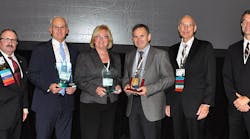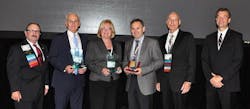Could water utilities someday provide the fuel to heat and cool our buildings? Chances are that they will do just that, according to Commissioner Patricia Acompora of the New York State Public Service Commission, speaking at this year’s International Ground Source Heat Pump Association’s (IGSHPA) Technical Conference and Expo in Kansas City, MO.
Dr. William Varley, President of American Water in New York, and Patricia Acampora, Commissioner at the New York Public Service Commission (PSC) were key note speakers, sharing their passion and ideas for use of the public water system’s infrastructure to provide service connections for geothermal heat pumps (GHPs) in the buildings they serve. GHPs tap renewable energy (RE) for about 80% of the delivered heating and cooling they provide.
The conference featured approximately 50 technical sessions, workshops and committees, with contributions by the US Department of Energy(DOE), major manufacturers, and suppliers. The message driving all this activity was clear: the geothermal HVAC industry is at center stage as a mainstream technology. Multi-billion dollar companies such as Carrier and Bosch are heavily invested in the GHP the market, and stakeholders were attending in force.
The Geothermal Vision
The Geothermal Technologies Office of the DOE has taken a renewed interest in GHPs, and was represented in a Geothermal Vision Study panel by Arlene Anderson, technology manager.
The Geothermal Vision Study Thermal Task Force was led by Dr. Xiaobing Liu of Oak Ridge National Laboratory (ORNL), who moderated a panel session in which individuals expressed their opinions about the future of GHPs.
IGSHPA Conference Chairman Jack DiEnna and associated trade representative Doug Dougherty (Chairman of the Geothermal Exchange Organization) agreed to serve as GTO Visionary Team members in an effort to provide high-level input to GTOs.
Training Initiatives
IGSHPA rolled out a new accreditation and training course for geothermal building inspectors, which is another sign that geothermal awareness is growing. Additionally, IGSHPA continues to provide needed certification in a number of areas including: Certified Geo-Exchange Design, Accredited Installers, Accredited Drillers, and Building Load Analysis.
Technical sessions covered topics such as net zero energy, commercial, institutional, and residential installation, technology, advocacy, and international standards.
Spreading the Word
The geothermal industry has made remarkable progress in efforts to get the word out, with the new “Geothermal Day” website, which provides up-to-the-minute information on the GHP industry.
Other new developments unveiled at the conference included:
• the HydrologicHydronic Panel from WaterFurnace, designed to make hydronic distribution easier for in buildings.
• EarthLinked featured their new unitary refrigerant-based-geothermal heat pump model.
• Versaprofiles showcased their latest version of thermally enhanced pipe, called GPXV2, demonstrating remarkable savings in drilling resources and labor costs. Professor Jasmin Raymond shared test results that confirmed 20%+ reductions in those costs.
Larger Role in Energy
The importance of the geothermal HVAC industry is integral in the world’s renewable energy (RE) efforts.
The White House recently released an aggressive energy plan to promote clean energy and energy efficiency, drive innovation, and ensure a cleaner, more stable environment for future generations.
Federal, state and local government have legislated to distance themselves from the burning of fossil fuel for heating. One example is in New York City. The City of New York committed to reduce its greenhouse gas (GHG) emissions by 80 percent from 2005 levels by 2050 (80 x 50), accelerating its initial target of a 30 percent reduction from 2005 levels by 2030 (30 x 30).
To date, citywide GHG emissions have fallen by more than 19 percent. Communities and governments throughout the world continue to make similar commitments.
We’ve used combustion in one form or another to keep warm since the discovery of fire. Combustion heating is no longer necessary, thanks to readily available electricity and the increasingly renewable-energy powered electrical grid. Electrical resistance heating is simple and clean, but uses about four times the energy that a GHP consumes for the same amount of heating. Geothermal heat pumps (GHPs) are the final answer for heating and cooling or buildings. Unlike air-source heat pumps (AHP’s), ground-source heat pumps (GHPs) can be designed with little or no need for back-up heat, making GHPs a necessity in the most (non-tropical) climates. There is no question of whether GHPs will be the main source of heating and cooling in the world. However, there are situations in concentrated urban areas in which placement of earth loops is a problem. The opportunity to use existing infrastructure provides the answer.
William Varley shared in his keynote address that on July 14, 2015, American Water announced that its subsidiary in New York piloted a geothermal innovation to heat and cool larger buildings. In this pilot program, the William L. Buck Elementary School in Valley Stream, New York, tapped into the water main running adjacent to the school. The school runs the water through a heat exchange unit within the school, safely providing the exchange water necessary for the school’s new GHPs used to heat and cool the building. New York’s Public Service Commission (PSC) is firmly behind the effort, and is supporting regulation of the water company as an energy utility.
Geothermal as a Utility
It is certain that GHPs are a big part of the future of renewable energy. The day is not too far distant in which we’ll hook up to the geothermal utility (be it the water company, or other entity) just as readily as we currently access our other utilities like water, sewer and high speed Internet. And, with the current pricing of broadband in this information age, geothermal energy may even cost less. Wouldn’t that be nice?
Jay Egg is founder/president of Egg Systems, a Florida-based provider of geothermal consulting, engineering and technologies. He is a consultant and designer of geothermal HVAC systems, in addition to being author of two books and several articles on the subject.








